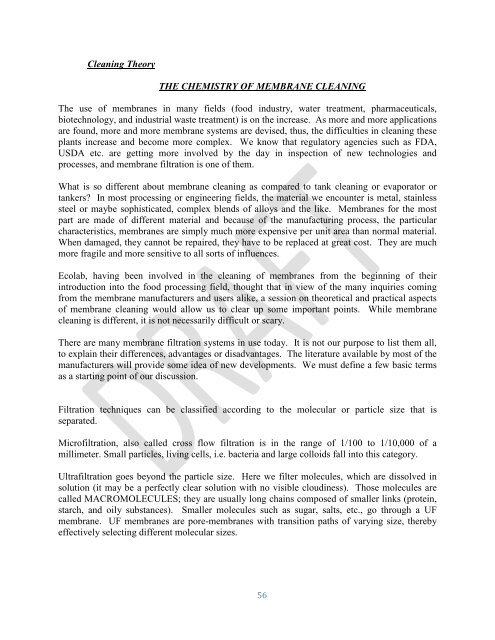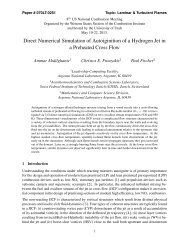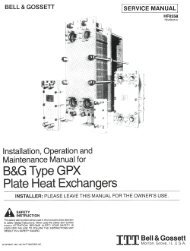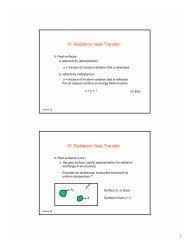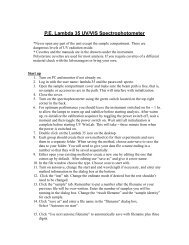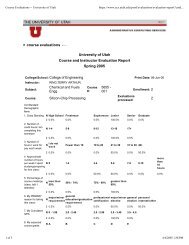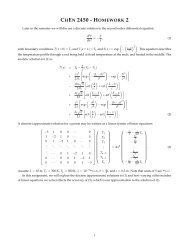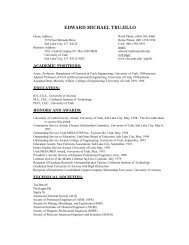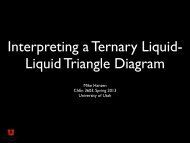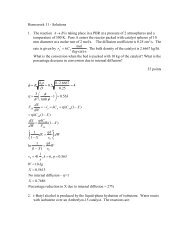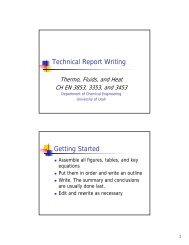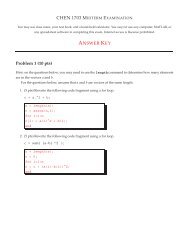Standard Operating Procedure - Ultrafiltration - Department of ...
Standard Operating Procedure - Ultrafiltration - Department of ...
Standard Operating Procedure - Ultrafiltration - Department of ...
- No tags were found...
You also want an ePaper? Increase the reach of your titles
YUMPU automatically turns print PDFs into web optimized ePapers that Google loves.
Cleaning TheoryTHE CHEMISTRY OF MEMBRANE CLEANINGThe use <strong>of</strong> membranes in many fields (food industry, water treatment, pharmaceuticals,biotechnology, and industrial waste treatment) is on the increase. As more and more applicationsare found, more and more membrane systems are devised, thus, the difficulties in cleaning theseplants increase and become more complex. We know that regulatory agencies such as FDA,USDA etc. are getting more involved by the day in inspection <strong>of</strong> new technologies andprocesses, and membrane filtration is one <strong>of</strong> them.What is so different about membrane cleaning as compared to tank cleaning or evaporator ortankers? In most processing or engineering fields, the material we encounter is metal, stainlesssteel or maybe sophisticated, complex blends <strong>of</strong> alloys and the like. Membranes for the mostpart are made <strong>of</strong> different material and because <strong>of</strong> the manufacturing process, the particularcharacteristics, membranes are simply much more expensive per unit area than normal material.When damaged, they cannot be repaired, they have to be replaced at great cost. They are muchmore fragile and more sensitive to all sorts <strong>of</strong> influences.Ecolab, having been involved in the cleaning <strong>of</strong> membranes from the beginning <strong>of</strong> theirintroduction into the food processing field, thought that in view <strong>of</strong> the many inquiries comingfrom the membrane manufacturers and users alike, a session on theoretical and practical aspects<strong>of</strong> membrane cleaning would allow us to clear up some important points. While membranecleaning is different, it is not necessarily difficult or scary.There are many membrane filtration systems in use today. It is not our purpose to list them all,to explain their differences, advantages or disadvantages. The literature available by most <strong>of</strong> themanufacturers will provide some idea <strong>of</strong> new developments. We must define a few basic termsas a starting point <strong>of</strong> our discussion.Filtration techniques can be classified according to the molecular or particle size that isseparated.Micr<strong>of</strong>iltration, also called cross flow filtration is in the range <strong>of</strong> 1/100 to 1/10,000 <strong>of</strong> amillimeter. Small particles, living cells, i.e. bacteria and large colloids fall into this category.<strong>Ultrafiltration</strong> goes beyond the particle size. Here we filter molecules, which are dissolved insolution (it may be a perfectly clear solution with no visible cloudiness). Those molecules arecalled MACROMOLECULES; they are usually long chains composed <strong>of</strong> smaller links (protein,starch, and oily substances). Smaller molecules such as sugar, salts, etc., go through a UFmembrane. UF membranes are pore-membranes with transition paths <strong>of</strong> varying size, therebyeffectively selecting different molecular sizes.56


